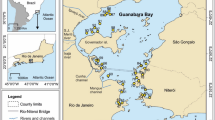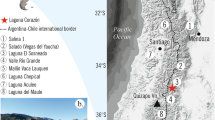Abstract
The structure and function of many Korean ecosystems have been rapidly modified since the 1960’s when industrialization of the nation began. Ulsan City was the first in Korea to develop into a major industrial complex. To assess anthropogenic impacts on ecosystems surrounding Ulsan, sediment cores were collected from Mujechi-neup (bog) and Sanggae reservoir of Ulsan, and these cores were 210Pb dated using the CRS model. Physical and chemical characteristics and pollen were analyzed, and the rates of sediment accumulation were calculated. Unsupported 210Pb inventories in Mujechi-neup and the Sanggae reservoir were 18.04 and 16.53 pCi cm−2, and the corresponding 210Pb fluxes were 0.56 and 0.52 pCi cm−2 yr−1, respectively. The overall accumulation rate of dry matter was 0.26 kg m−2 yr−1 since 1852 (14 cm in depth) in Mujechi-neup. In the Sanggae reservoir, the accumulation rates of dry matter were increased from 2.1 in 1965 to 6.0 kg m−2 yr−1 in 1999. Pollen analysis revealed that three pollen zones existed in Mujechi-neup; a Pinus pollen-dominated zone from 0 to 5 cm in depth (1974 year), an Alnus pollen-dominated zone from 5 to 15 cm in depth (1827 year), and a Quercus pollen-dominated zone below 15 cm in depth. The shift from an Alnus dominated zone to a Pinus dominated zone was related to the Korean War between 1951 and 1953 and reforestation activities in the 1970’s. In the Sanggae reservoir, there was an increase of Humulus pollen since 1996, an increase of Ambrosia pollen since the 1960’s and the decrease of Graminae pollen since 1993 with the expansion of the industrial area. Similar to Mujechi-neup, the Sanggae reservoir also consists of three pollen zones: a Pinus and Typha pollen-dominated zone from 0 to 10 cm in depth (since 1993), a Graminae pollen-dominated zone from 10 to 22 cm in depth (between 1947 and 1993), and a Pinus pollen-dominated zone below 22 cm in depth (before 1947). The increase of Typha and Humulus in the 1990’s indicates an increase in the inflow of nutrients into the wetlands. Also, pollen analysis revealed that Ambrosia was introduced in the 1960’s during industrialization of the area. The sediment was composed of humic peat in Mujechi-neup and was composed of clay in the Sanggae reservoir. High LOI, P, and low C/N ratio between the depths of 5 to 7 cm in the Sanggae reservoir indicates an increased input of P and N. As a result, the growth of Typha was at its maximum. The total Pb content in Mujechi-neup has been increasing since the 1870’s, and its accumulation in the Sanggae reservoir has been increasing since the 1960’s. Thus, the history of local-scale disturbances and human activities in the watershed was reconstructed through paleoecological studies in Ulsan.
Similar content being viewed by others
References
P.G. Appleby F. Oldfield (1986) ArticleTitleThe calculation of 210Pb dates assuming a constant rate of supply of unsupported 210Pb to the sediment Catena 5 1–8
Appleby P.G. and Oldfield F. 1992. Application of 210Pb to sedimentation studies. In: Ivanovich M. and Harmon R.S. (eds.), Uranium-Series Disequilibrium: Application to Earth, Marine and Environmental Sciences. Oxford University Press, pp. 731–778.
S.M. Bartow C.B. Craft C.J. Richardson (1996) ArticleTitleReconstructing historical changes in Everglades plant community composition using pollen distributions in peat Lake Res. Mgmt. 12 313–322
G. Billen J. Garnier (1997) ArticleTitleThe Phison River plume: coastal eutropication in response to changes in land use and water management in the watershed Aquat. Microb. Ecol. 13 3–17
M.W. Binford (1990) ArticleTitleCalculation and uncertainty analysis of 210Pb dates for PIRLA project lake sediment cores J. Paleolimnol. 3 253–267 Occurrence Handle10.1007/BF00219461
M.W. Binford J.S. Kahl S.A. Norton (1993) ArticleTitleInterpretation of 210Pb profiles and verification of the CRS dating model in PIRLA project lake sediment cores J. Paleolimnol. 9 275–296 Occurrence Handle10.1007/BF00677218
J. Boyle (2004) ArticleTitleA comparison of two methods for estimating the organic matter content of sediments J. Paleolimnol. 31 125–127 Occurrence Handle10.1023/B:JOPL.0000022549.07298.6e
W.R. Boynton J.H. Garber R. Summers W.M. Kemp (1995) ArticleTitleInputs, transformations, and transport of nitrogen and phosphorus in Chesapeake Bay and selected Tributaries Estuaries 18 285–314 Occurrence Handle1:CAS:528:DyaK2MXotFGns7o%3D
J.P. Bradbury P.C. van Metre (1997) ArticleTitleA land-use and water-quality history of White Rock Lake reservoirDallas, Texas, based on paleolimnological analysis J. Paleolimnol. 17 227–237 Occurrence Handle10.1023/A:1007923829759
S.R. Carpenter N.F. Caraco D.L. Correll R.W. Howarth A.N. Sharpley V.H. Smith (1998) ArticleTitleNonpoint pollution of surface waters with phosphorus and nitrogen Ecol. Appl. 8 539–568
N.-K. Chang N.-I. Kim J.G. Kim (1988) ArticleTitleVariation of Deposition Time and Amount of Airborne Pollens in Mt. Kwan-ak Korean J. Ecol. 11 123–130
K.-R. Choi (2001) ArticleTitlePalynological study of Moojechi bog. Korean J. Quat. Res. 15 13–20
C.B. Craft C.J. Richardson (1998) ArticleTitleRecent and long-term organic soil accretion and nutrient accumulation in the Everglades Soil Sci. Soc. Am. J. 62 834–843 Occurrence Handle1:CAS:528:DyaK1cXks1eqt7o%3D
Culture and Information Officer (ed). 1987. History of Ulsan City. Ulsan City.
M.B. Davis (1973) ArticleTitlePollen evidence of changing land use around the shores of Lake Washington Northwest Sci. 47 133–148
W.E. Dean SuffixJr. (1974) ArticleTitleDetermination of carbonates and organic matter in calcareous sediment and sedimentary rocks by loss on ignition: comparison with other methods J. Sed. Petrol. 44 242–248 Occurrence Handle1:CAS:528:DyaE2cXkt1Snurg%3D
K. Faegri J. Iverson (1989) Textbook of Pollen Analysis John Wiley and Sons New York 328
History Editorial Committee of Ulsan-Ulju. 1978. Local History of Ulsan-Ulju. Ulsan city (in Korean).
J.G. Kim (2001) ArticleTitleDecomposition of plant material in a subalpine marsh J. Plant Biol. 44 73–80
J.G. Kim (2002) ArticleTitleA study on soil particle size in mountains of Seoul vicinity for forest restoration J. Korean Soc. Env. Rest. Reveg. Technol. 5 1–8
J.G. Kim (2003) ArticleTitleResponse of sediment chemistry and accumulation rates to recent environmental changes in the Clear Lake WatershedCaliforniaUSA Wetlands 23 95–103
J.G. Kim N.-K. Chang (1989) ArticleTitleLitter production and decomposition in the Pinus rigida plantation in Mt. Kwan-ak Korean J. Ecol. 12 9–20
J.G. Kim E. Rejmánková (2001) ArticleTitleThe paleoecological record of human disturbance in wetlands of the Lake Tahoe Basin J. Paleolimnol. 25 437–454 Occurrence Handle10.1023/A:1011176018331
J.G. Kim E. Rejmánková H.J. Spanglet (2001) ArticleTitleImplication of a sediment-chemistry study on subalpine marsh conservation in the Lake Tahoe basin, USA Wetlands 21 379–394
J.O. Kim (1997) Modern scientific technology and environmental problems H.J. Kim (Eds) Challenge and Selection of Korea Nanam Publishers Seoul 796–817
Kim J.W., Lee Y.K., Kim J.H., Lee Y.J. and Jegal J.C. 1998. Vegetation of Woong-moor and Ja-moor of Mujechi-neup and conservation strategy. In: Ministry of Environment. 2nd year Report of Survey Results of Mujechi-neup in Mt. Jeongjok, pp. 34–53 (in Korean).
C.-S. Lee Y.-H. You G.R. Robinson (2002) ArticleTitleSecondary succesiion and natural habitat restoration in ababdoned rice fields of Central Korea Rest. Ecol. 10 306–314 Occurrence Handle10.1046/j.1526-100X.2002.00003.x
M.H. Lee K.C. Lee M.S. Lee J.K. Yun J.C. Lee S.W. Jung K.T. Lee J.K. Kang S.H. Chang (1998) ArticleTitleA study on the residual status of haxardous substances in soil (II) – Petrochemical industrial area at MIPO national industrial complex in Ulsan – Report of NIER Korea 20 259–270 Occurrence Handle1:CAS:528:DyaK1cXjvVeisLg%3D
G.E. Likens C.T. Driscoll D.C. Buso T.G. Siccama z C.E. Johnson G.M. Lovett D.F. Ryan T. Fahey W.A. Reiners (1994) ArticleTitleThe biogeochemistry of potassium at Hubbard Brook Biogeochemistry 25 61–125 Occurrence Handle1:CAS:528:DyaK2cXmtFahu78%3D
Ministry of Environment. 1998. 2nd year Report of Survey Results of Mujechi-neup in Mt. Jeongjok. (in Korean).
H.-T. Mun (1997) ArticleTitleEffects of colony nesting of Adrea cinereaEgretta alba modesta on soil properties and herb layer composition in a Pinus densiflora forest Plant Soil 197 55–59 Occurrence Handle10.1023/A:1004292103610 Occurrence Handle1:CAS:528:DyaK1cXjs12msw%3D%3D
H.-T. Mun Y.-S. Chung (1996) ArticleTitleEffects of forest fire on soil nutrients in pine forests in Kosong, Kangwon province Korean J. Ecol. 19 375–383
National Institute of Korean History. 1982. Modern History of Korea. Tamgudang, Seoul, 405 pp. (in Korean).
J.-K. Park N.-K. Chang (1998) ArticleTitlePast vegetation of Moojaechi on Mt. Jungjok by pollen analysis Korean J. Ecol. 21 427–433
J.D. Smith T.F. Hamilton (1984) ArticleTitleImproved technique for recovery and measurement of polonium-210 from environmental materials Anal. Chim. Acta 160 69–77 Occurrence Handle10.1016/S0003-2670(00)84509-2 Occurrence Handle1:CAS:528:DyaL2cXlt1aitL0%3D
J.P. Smol (1992) ArticleTitlePaleolimnology: an important tool for effective ecosystem management J. Aquat. Ecosyst.Health 1 49–58 Occurrence Handle10.1007/BF00044408
K.K. Turekian Y. Nozaki L. Benninger (1977) ArticleTitleGeochemistry of atmospheric radon and radon products Annu. Rev. Earth Planet. Sci. 5 227–255 Occurrence Handle10.1146/annurev.ea.05.050177.001303 Occurrence Handle1:CAS:528:DyaE2sXkvVOrtLw%3D
R.K. Wieder M. Novak W.R. Schell T. Rhodes (1994) ArticleTitleRates of peat accumulation over the past 200 years in five Sphagnum-dominated peatlands in the United States J. Paleolimnol. 12 35–47 Occurrence Handle10.1007/BF00677988
Author information
Authors and Affiliations
Corresponding author
Rights and permissions
About this article
Cite this article
Kim, J. Assessment of recent industrialization in wetlands near Ulsan, Korea. J Paleolimnol 33, 433–444 (2005). https://doi.org/10.1007/s10933-004-7617-6
Received:
Accepted:
Issue Date:
DOI: https://doi.org/10.1007/s10933-004-7617-6




